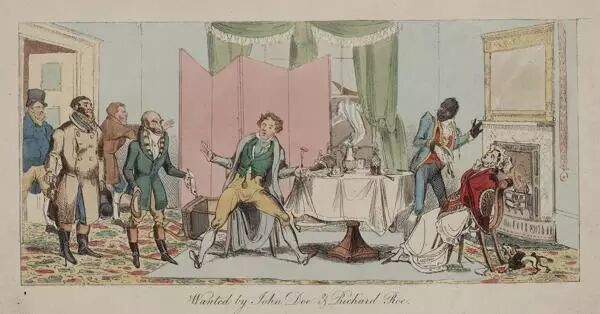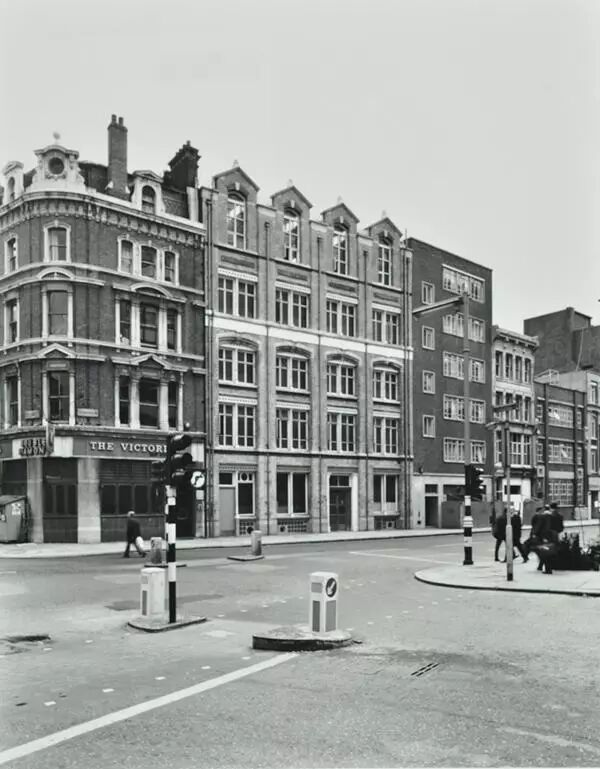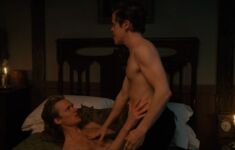
Thanks to shows like Queen Charlotte and the regular trickle of Austen adaptations, most of us are familiar with the Regency period, the decade between 1811 and 1820 when the wealthy English aristocracy ruled. It was a world of hot goss, fresh threads (silk and tulle, in this case), and manners so refined they could almost hide the hierarchical tensions that simmer beneath the banter.
If that setup sounds familiar, it should. Joel Kim Booster knew what he was doing when he set his adaptation of Pride and Prejudice on last year’s Hulu hit Fire Island: subtlety ruled the Regency’s social world, and a meaningful glance or an arched eyebrow could wreak absolute emotional devastation. Compare your average West Village brunch conversation to an after-dinner gathering in an Austen book, and you’ll hear the same codes of indirect meaning and implication.
Yet in most of the modern stories set in the Regency, we see hardly any gay characters at the balls and tea parties. It makes you wonder: in the actual Regency era, where did all the gay men go?
History’s got an answer: they went to the molly house!

Before you start hunting for a time machine, it’s not that molly. Throughout the eighteenth and early nineteenth century, molly meant a gay man.
“Mollies” would meet in taverns, alehouses, or coffee-houses (think less Starbucks, more cafe-and-hostel) for discreet encounters of the racy kind. Some came to meet new prospects, others brought men they’d met elsewhere to, ahem, seal the deal, and the ones with no game could hire live-in male prostitutes at the richer establishments. All found booze, dancing, and the freedom to experiment with feminine fashion without judgment.
We first hear of molly houses in 1700, mostly through court transcripts and the hysterical articles of investigative journalists. In the 18th century, the molly house that attracted the most gasping and pearl-clutching was Mother Clap’s Molly House in the Holborn borough of London.
Though a married couple co-owned the place, it was the wife, Margaret Clap, who held court in the main room. Up to forty or fifty men gathered there, drinking, dancing, kissing, and “[made] Curtsies, and [mimicked] the voices of Women” while “using their Hands indecently.” It’s all fun, indecent times until the po-po raid your bar, which happened to Mother Clap’s in 1725.

Secrecy was the name of the game for these molly houses. Engaging in penetrative sex between men could land you a conviction of sodomy, which meant facing enraged crowds throwing dead animals, rotten veggies, and even potatoes at you while you’re stuck in the pillory. The unluckiest ones ended up in prison or even on the gallows.
Molly houses protected themselves by posting lookouts, vetting newcomers, and demanding passwords at the door (one of them was “sister”). Sources guess that about forty molly houses existed in London alone through the early 1700s, at a time when the city’s population numbered about 630,000. Think of West Hollywood if all its gay bars turned into underground speakeasies, and you’ve got the vibe.
Why take the risk of opening a molly house? Jessie J got it wrong here: it’s all about the money, money, money. A molly house could make its owner rich– or so a would-be entrepreneur named Yardley claimed in 1810, when he convinced James Cook to open a molly house with him. They opened their coffee-house on Vere Street and dubbed it the White Swan Inn. The money rolled in for six months before the po-po showed up, arresting over twenty patrons and staff.
If Cook didn’t become a molly house millionaire, at least he could afford a lawyer. That legal champion, Robert Halloway, took it upon himself to publish The Phoenix of Sodom in 1813. Despite a title straight out of a melodramatic Harry Potter fanfic, it’s a defense of Cook’s reputation that just happens to describe the Swan’s operations in juicy detail.

Like a thesaurus written by Puritans, Holloway uses approximately five hundred euphemisms for “gay sex.” Picking through the “unnatural sin” this and “pile of diabolism” that, though, we glimpse some fascinating tidbits.
The clientele seemed to include both “men of rank” and “wretches of the lowest description,” many with a taste for petticoats and bonnets. We hear assumed names like Miss Sweet Lips, Black-Eyed Lenora, the Duchess of Devonshire, and the Countess of Camomile (yet no Lady Gray). But if you’re picturing a drag queen lineup, Holloway notes both “effeminate delicate beings” and burly coal-shovelers.
Most intriguing of all, he hints at a much larger molly house scene. He mentions “there are many about town,” and even that “there is scarcely any description of men” that doesn’t include mollies. Even the man who couldn’t name the actual subject of his book knew that Regency London was hella gay.
Holloway was most interested in the Swan’s upstairs rooms. One was decorated like a lady’s dressing room with an array of perfume and makeup for customers. Another held a chapel where male-male couples would be “married” in a faux ceremony and then consummate their nuptials on one of several beds, sometimes in sight of other couples. Some couples would even act out pregnancy and “give birth” to a wooden doll that they’d then baptize.

If this sounds like your old college roommate’s performance art, add one more oddity to the list: the Swan’s wedding ceremonies were officiated by an actual clergyman, the Reverend John Church. He was accused several times of sodomy but never convicted.
According to historian Rictor Norton, “all the evidence indicates that John Church was a sincere, perhaps even pious, man who believed that gay love was congruent with the Christian way of life.” In 1810, someone knew that you could be a Christian without being a homophobe. Imagine that.
While the raid resulted in eight convictions and the Vere Street Coterie became the objects of loathing and hatred, times were changing. Though sodomy remained a crime in English law until 1969, death sentences became rarer, and the year 1835 marked the last execution for sodomy in England.
At the same time, gay men found a new gathering space: public baths. England’s first salt-water bath opened in Liverpool in 1828. By 1839, we see mentions of gay sex occurring in bathhouses. With the Baths and Washhouses Act of 1846 helping parishes build more public baths, it’s no wonder that molly houses disappear from the historical record by the mid-nineteenth century.
Yet every time a drag queen uses a royal title and a gay man refers to himself as “she,” the spirit of the molly house lives on– thankfully, with no wooden dolls in sight.
Related:
‘Bridgerton’ spinoff’s gay romance gets very steamy very quickly & it has fans divided
In the past, ‘Bridgerton’s’ been accused of queerbaiting, and ‘Queen Charlotte’ attempts to right those wrongs—but is it enough?



















ShaverC
Interesting history but “…Regency period, the decade between 1811 and 1820 when the wealthy English aristocracy ruled.” makes it sound like the aristocracy only ruled England between those dates… they ruled well before and even after.
Kangol2
ShaverC, you’re correct. The writer’s language was unclear. The Regency period officially refers to the final third of the Georgian period, when Prince George, Prince of Wales, took over the running of the country, as regent, as his father, George III (1760-1820), suffered through a near-decade of severe illness, after initially falling ill in the late 1780s.
George III’s overall reign (including the decade with the soon-to-become George IV as regent) coincided with major geopolitical events, including the Seven Years’ War against France, the American Revolution (1775-1783), the British-American War of 1812, the Napoleonic Wars, and many others, but this particular decade was a significant one in social and cultural terms as well. The larger Regency period in British history refers to the 1795-1830s.
As you note, the British aristocracy have controlled the country in various ways for most of its history, though increasingly less so since the 19th century.
Fahd
Seems that a molly house may have been more than just a brothel for gay men.
Does anyone use the word, mollycoddle, any more (as in “Stop molllycoddling the boy.”)?
gothvixen
It doesn’t insinuate anything else. A molly was an “overly pampered, fastidious, effeminate male.” If you were trying to suggest anything else you’re wrong. In England people still use mollycoddle, mainly in the north, but there’s nothing suggested other than it might make a boy effeminate. It’s still homophobic and crass. but there’s NO other suggestion. You’re like a gutter journalist, except one who wouldn’t be paid because their reports were trash.
Joshooeerr
While Molly Houses certainly served as gay bars, it is not quite true to say they were the *equivalent* of a modern gay bar. The mollies and the clientele were all about cross-dressing and there were many activities and rituals based around cross-dressing and intricately aping female roles (even including childbirth role-plays with dolls). This is the culture that dominated and it seems that regular gay guys (i.e. the majority) would turn up for the sex and barely tolerate the endless Molly play. It’s all detailed in Rictor Norton’s book Mother Clapp’s Molly House and Mark Ravenhill’s play of the same name, based on the book.
theaterbloke
Excellent play! I saw it at the National years ago with a young Dominic Cooper. It contrasted the Molly House with contemporary gay life.
Kangol2
Great points and the Norton book is excellent!
Greg
My God, the Norton book is going from $240 to nearly a $1,000 online.